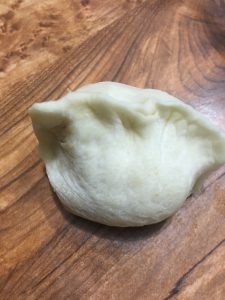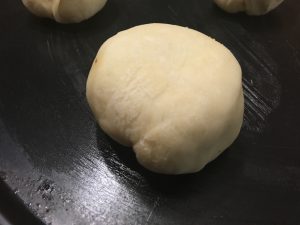Feeling pleased — patty dough + seeni sambol + egg = very tasty. Will write up experiments when I get a chance, but for now, must finish grading.



with Mary Anne Mohanraj
Feeling pleased — patty dough + seeni sambol + egg = very tasty. Will write up experiments when I get a chance, but for now, must finish grading.


Mas Paan is literally ‘meat bread,’ and is a favorite snack sold at roadside stands, hotel cafes, and transit stations across Sri Lanka. The yeast bread may be filled with whatever curry you like — fish and vegetarian options are also common. This batch, I made with some leftover pork and potato curry, but most often, I would make this with beef and potato curry. Regardless, having thirty mas paan in my fridge and freezer means that I’ll snack happy for a few days, take them with me while traveling — they’re great to have on the road — and be able to pull some out of the freezer to toast up when I get home again. It’s best piping hot, but may also be happily eaten at room temperature.
Note: If you don’t want to make the dough by hand, and your grocery store carries frozen loaves of bread dough, I’ve thawed and used a pair of those for this recipe to good effect. This recipe adapted from Charmaine Solomon’s _The Complete Asian Cookbook_, with very little change.
Note 2: Minal Hajratwala has a fascinating chapter that explores the political significance of similar buns in South Africa, in her book on the diaspora, _Leaving India_. Highly recommended.
Mas Paan
(about three hours + currying time, makes 30)
1 batch meat and potato curry (about 2-3 lbs. meat, 3 russet potatoes)
Dough:
1/2 c. milk
3 t. sugar
2 1/2 t. salt
3 oz. butter
1 1/2 c. warm water
1 packet (about 2 1/4 t.) active dry yeast
5 1/2 – 6 c. all-purpose or bread flour
1. Make curry, if needed; it’s tempting to make it while the dough is proving, but the timing can be tricky, since the curry needs to cool down, and your dough may overprove, turning yeasty. (I admit to risking it on occasion, though, for efficiency’s sake.) The curry should be cooked until it is very dry, and then cooled down to room temperature.

2. Make dough: Scald milk, stir in sugar, salt and butter and cool to lukewarm. Measure warm water into a large bowl; stir yeast into water until dissolved. Add milk mixture and 3 c. of flour; beat until smooth. Add enough flour to make a soft dough. Turn onto a lightly floured board, and knead until smooth and elastic, about ten minutes. Grease a bowl with butter, then put the dough ball in, turning it to make sure it’s all greased. Cover with plastic wrap or a cloth and allow to prove in a warm place until doubled in bulk (inside a turned off oven works well), about 1 – 1.5 hours. (This recipe is also used for making breudher in Sri Lanka.)

3. Divide the dough into 30 equal portions, flatten each portion to a circle and put a spoonful of meat and potato curry in the center. Bring the edges together, pressing to seal. If you keep the dough thinner at the edges when you’re flattening it, that’ll help keep it from being too bready at the bottom.




4. Grease baking trays and put buns with the join downwards on the trays, leaving room for them to rise and spread. Cover with a dry cloth and again, leave in a warm place for 30-40 minutes until nearly doubled in bulk.

5. Brush with egg glaze (egg whites or even heavy cream may be used instead) and bake in a hot oven until golden brown, about 10 minutes. Lovely with hot, sweet, milky tea.

I’m not sure this problem ever came up in Sri Lanka, but we eat Western food about half the time, and I like lots of it, really I do, but then sometimes I go to the fridge to eat some leftovers and there is no curry to be found and I am sad. Over the years I’ve learned that it’s actually easy to take a standard plain-cooked meat, chicken, or fish, and turn it into an acceptable curried version. When a girl is desperate for curry, she does what she needs to do — she makes a curry sauce, adds some cut-up leftover cooked meat, simmers it for a little bit, and eats happy.
3 medium yellow onions, chopped
1 T ginger, grated
3 cloves garlic, chopped
1 t. mustard seed
1 t. cumin seed
1 dozen curry leaves
3 cloves
3 cardamom pods
1 2-inch piece cinnamon
1-2 T chili powder
1 t. Sri Lankan curry powder
1 t. salt
1/4 c. ketchup
1-2 T Worcestershire sauce
1/2 – 1 c. (or more, if you like) coconut milk
2-3 lbs. leftover cooked meat, cubed (may also be left on the bone)
3 russet potatoes, cubed (optional)
1. Sauté onions in oil or ghee on medium-high, stirring as needed, with ginger, garlic, mustard seed, cumin seed, curry leaves, cloves, cardamom, cinnamon, until golden-translucent, about ten minutes.
2. Add chili powder, Sri Lankan curry powder, and salt, stirring for a few minutes more.
3. Add ketchup, Worcestershire sauce, and coconut milk, stirring each ingredient in. You now have a basic curry sauce, suitable for meat, chicken, or fish. (It also works with seitan or young jackfruit, for vegetarian options.)
4. Add leftover cooked meat, stirring until well combined. Turn down to a simmer, cover, and let cook ten minutes or so; the meat will impart some flavor to the sauce, and vice versa. Add water if necessary to prevent burning.
5. Add potatoes (and probably more water) if using, bring to boiling, then turn back down and simmer until potatoes are cooked through. (You can speed this part up by par-cooking them in water in the microwave earlier, perhaps while your onions are sautéing.) Cook sauce down until it has a thick consistency, like gravy.
Serve hot, with rice or bread.
This isn’t so much of a recipe, as a test of whether I’ve managed to automate posting to Facebook from this site. But here’s a picture of the classic ribbon sandwiches, made with just beets and carrots (leaving out the traditional spinach), on wheat bread, for a more autumnal look. Nice for a Thanksgiving party appetizer!

We had crepes for dinner last night, and I started with my favorite, lemon + sugar. Delicious as always, but then I thought, what if I desi-fy’d (desified?) it? So I tried lime + jaggery, and reader, it was good.
We also had some ripe persimmon, which I love, so I tried that — interestingly, the version I did with nutmeg / cinnamon / allspice, which I thought would work well, didn’t excite me. But the version with persimmon / salt / pepper was surprisingly delicious. I think it’s because the persimmons were so sweet?







Mackerel (or Ground Beef, or Vegetable) Cutlets
(90 minutes, makes about 50)
There’s a part of my mind (formed in childhood over monthly Sri Lankan birthday parties at various aunties’ homes) that says a party isn’t properly a party unless there are rolls and cutlets. So when people agree to come over to my house and let me feed them rolls and cutlets, it makes that childhood bit of me very happy.
Some Americans find these too fishy, but I love them. Over the years, my family has come up with adaptations to suit the tastes of those (like Kevin) who dislike fish, and they’ve even come up with a variation for vegetarians. But honestly, the mackerel ones are the tastiest.
I wouldn’t recommend attempting this recipe unless you’re willing to get your hands dirty (and fishy-smelling)—you really need to work the filling with your hand to blend and shape it properly.
2 cans of mackerel, 15 oz each
2 large russet potato
4 medium onions, chopped fine, for sautéing
1 tsp black mustard seed
1 tsp cumin seed
2 TBL oil or ghee
1 rounded tsp salt
2/3 cup lime juice
2 small onions, minced, for mixing in
4 rounded tsp finely chopped fresh Thai green chilies
1 rounded tsp ground black pepper
2 egg, beaten
dry breadcrumbs, for coating
oil for deep frying
For ground beef cutlets: For 2 lb lean ground beef, when you sauté the 4 chopped onions, add 1-2 heaping tsp red Indian chili powder and 1/2 cup ketchup, as well as the 1/2 rounded tsp salt from above. Add the ground beef (skipping the lime juice), and fry until very dry, draining any excess oil. Skip the raw onion, chilies and black pepper—proceed otherwise as for the fish cutlets.
For vegetable cutlets: Just use 1 lb frozen mixed vegetables, thawed (you might have to cut up the green beans into smaller pieces). Sauté the onions, mustard seed, and cumin seed as for the fish; add the vegetables and salt and cook until very dry. Skip the raw onion if you like, but definitely stir in an extra 1/2 tsp of salt when you mix the veggies in with the potatoes, black pepper and chilies. Proceed otherwise as for the fish cutlets.

Apple-cheddar biscuits. Barely a recipe, since this is a weeknight quick thing — Pillsbury biscuits sliced in half, layered with sliced apples and pre-shredded cheese. I’m sure it would be tastier if you grated your own cheese and baked the biscuits from scratch, but sometimes tired mama just needs to do five minutes of prep and toss it in the oven.

My kids LOVE them, and sliced in half, they’re a nice addition to this evening’s wine-and-cheese political meet-and-greet with Brandon Johnson (running for Cook County Commissioner), esp. if anyone coming brings their kids.

